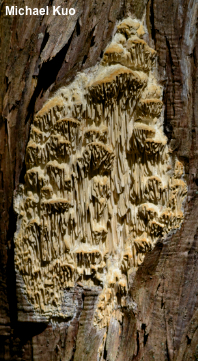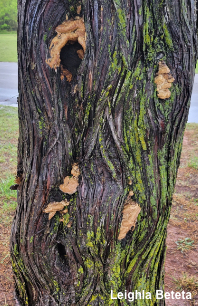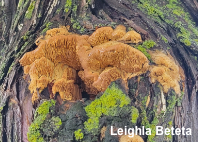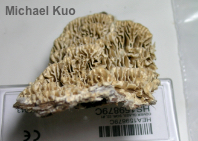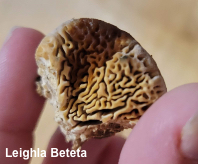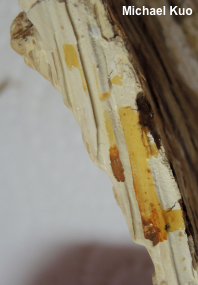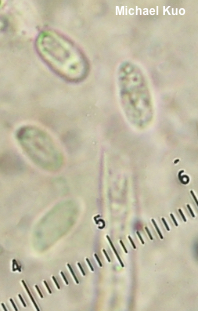| Major Groups > Polypores > Antrodia juniperina |

|
Antrodia juniperina [ Basidiomycota > Polyporales > Fomitopsidaceae > Antrodia . . . ] by Michael Kuo Found exclusively on the wood of junipers, this distinctive polypore spreads a lengthening pore surface underneath a half-hearted cap structure and, as the tubes elongate, the "pores" start to look more like long, flattened teeth. The fungus is reminiscent of Spongipellis pachyodon, but the latter grows on oaks, is usually paler when fresh, and differs microscopically. Daedalea juniperina is a synonym. "Brunneoporus juniperinus" is silliness—an unscientific name published online, without peer review and without taxonomic diligence, citing support by three sources that do not actually support the new genus, creating it without reference to contemporary standards (the standard is Vellinga et al 2015, "Six simple guidelines for introducing new genera of fungi"; the Brunneoporus "publication" literally fails to meet five of the six guidelines). Thanks to Chris Crabtree for teaching me this species. Thanks to Leighla Beteta for documenting, collecting, and preserving Antrodia juniperina for study; her collection is deposited in The Herbarium of Michael Kuo. Description: Ecology: Saprobic on the wood of junipers (species of Juniperus), including eastern redcedar, Rocky Mountain juniper, and Utah juniper; causing a brown rot; growing alone or gregariously; perennial; fairly widely distributed in North America, following the distribution of the host trees. The illustrated and described collection is from Missouri. Cap: Sometimes absent, but when present effused-reflexed, extending 1–3 cm from the tree; whitish to brownish, often with a yellow-brown margin; at first matted-fuzzy but becoming more or less bald with age. Pore Surface: Distinctive; spreading in resupinate fashion 8–15 cm below the cap and 5–8 cm across; pores when very young or near the margin of the cap slot-like, 1–2 mm wide—but the tubes soon lengthen and appear more or less like long, flat teeth; whitish to yellowish; not bruising; when viewed from a 90-degree angle appearing slot-like overall (like the pores of Daedalea quercina). Stem: Absent. Flesh: Very tough; whitish; not changing on exposure. Odor: Not distinctive. Chemical Reactions: KOH yellow to brown on flesh and tubes. Spore Print: White. Microscopic Features: Spores 5.5–7.5 x 2.5–3 µm; long-ellipsoid; smooth; hyaline in KOH; inamyloid. Basidia 20–25 x 4–5 µm; clavate; 4-sterigmate. Cystidia not found. Setae not found. Hyphal system dimitic; generative hyphae 2–4 µm thick, thin-walled, smooth, hyaline in KOH, with clamp connections; skeletal hyphae 4–6 µm thick, with walls 1–1.5 µm thick, smooth, hyaline to golden in KOH. REFERENCES: (Murrill, 1905) Niemelä & Ryvarden, 1975. (Overholts, 1953; Gilbertson & Ryvarden, 1986; Ortiz-Santana et al., 2013; Justo et al., 2017.) Herb. Kuo 09301702, 05052201. This site contains no information about the edibility or toxicity of mushrooms. |
© MushroomExpert.Com |
|
Cite this page as: Kuo, M. (2022, July). Antrodia juniperina. Retrieved from the MushroomExpert.Com Web site: http://www.mushroomexpert.com/antrodia_juniperina.html |
